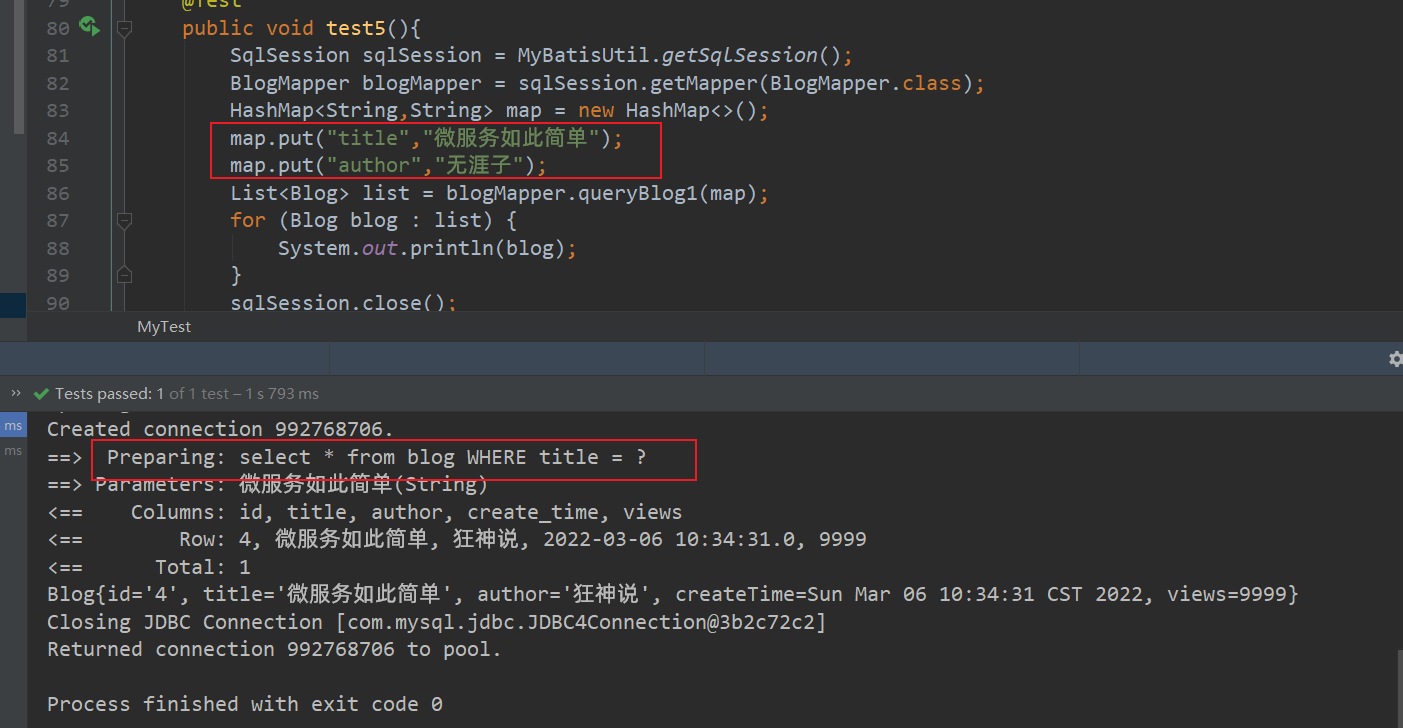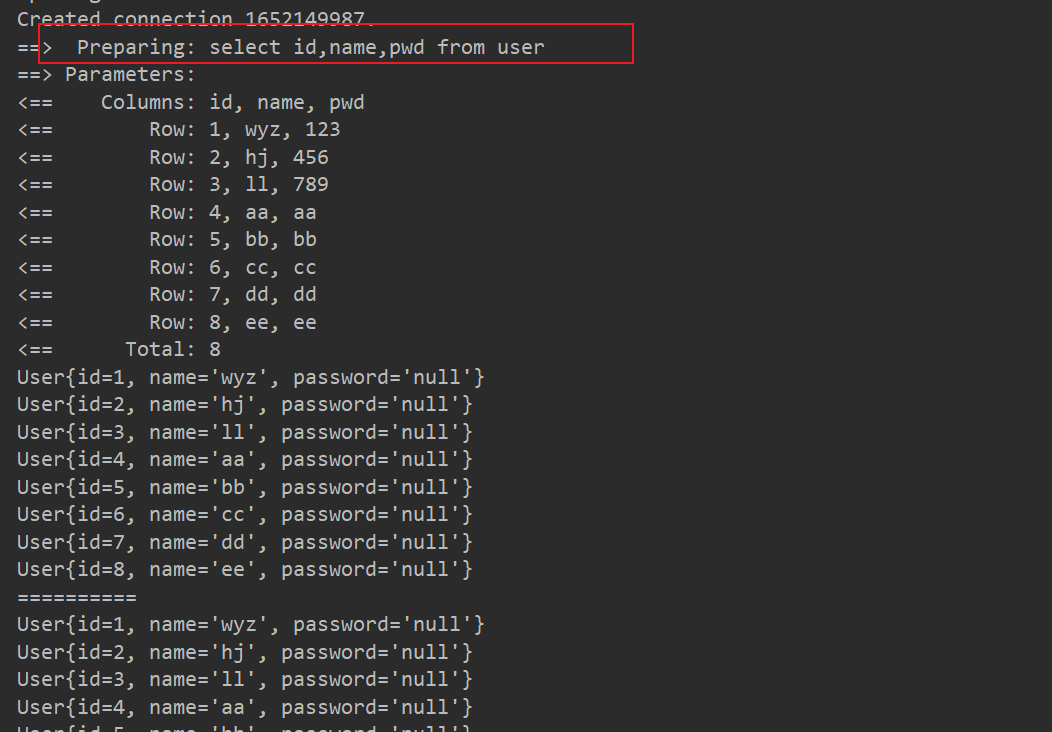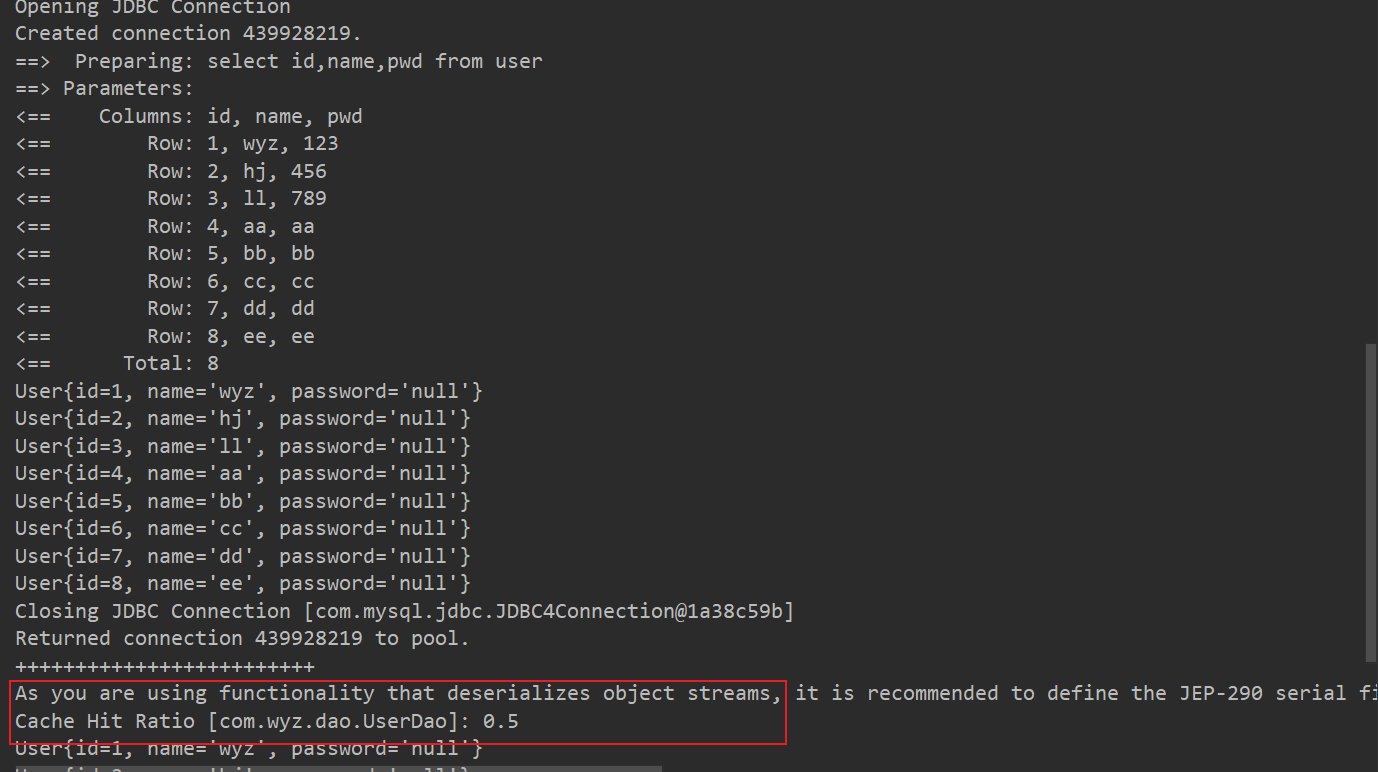动态SQL和缓存
6.动态SQL
动态 SQL 是 MyBatis 的强大特性之一。如果你使用过 JDBC 或其它类似的框架,你应该能理解根据不同条件拼接 SQL 语句有多痛苦,例如拼接时要确保不能忘记添加必要的空格,还要注意去掉列表最后一个列名的逗号。利用动态 SQL,可以彻底摆脱这种痛苦。
使用动态 SQL 并非一件易事,但借助可用于任何 SQL 映射语句中的强大的动态 SQL 语言,MyBatis 显著地提升了这一特性的易用性。
如果你之前用过 JSTL 或任何基于类 XML 语言的文本处理器,你对动态 SQL 元素可能会感觉似曾相识。在 MyBatis 之前的版本中,需要花时间了解大量的元素。借助功能强大的基于 OGNL 的表达式,MyBatis 3 替换了之前的大部分元素,大大精简了元素种类,现在要学习的元素种类比原来的一半还要少。
- if
- choose (when, otherwise)
- trim (where, set)
- foreach
6.1 搭建环境
重新定义一个数据库表
CREATE TABLE `blog` (
`id` varchar(50) NOT NULL COMMENT '博客id',
`title` varchar(100) NOT NULL COMMENT '博客标题',
`author` varchar(30) NOT NULL COMMENT '博客作者',
`create_time` datetime NOT NULL COMMENT '创建时间',
`views` int(30) NOT NULL COMMENT '浏览量'
) ENGINE=InnoDB DEFAULT CHARSET=utf8
创建Bean,Dao,Mapper.xml文件
public class Blog {
private String id;
private String title;
private String author;
private Date createTime;
private int views;
public Blog(String id, String title, String author, Date createTime, int views) {
this.id = id;
this.title = title;
this.author = author;
this.createTime = createTime;
this.views = views;
}
public Blog() {
}
public String getId() {
return id;
}
public void setId(String id) {
this.id = id;
}
public String getTitle() {
return title;
}
public void setTitle(String title) {
this.title = title;
}
public String getAuthor() {
return author;
}
public void setAuthor(String author) {
this.author = author;
}
public Date getCreateTime() {
return createTime;
}
public void setCreateTime(Date createTime) {
this.createTime = createTime;
}
public int getViews() {
return views;
}
public void setViews(int views) {
this.views = views;
}
@Override
public String toString() {
return "Blog{" +
"id='" + id + '\'' +
", title='" + title + '\'' +
", author='" + author + '\'' +
", createTime=" + createTime +
", views=" + views +
'}';
}
}
public interface BlogMapper {
int addBlog(Blog blog);
}
<?xml version="1.0" encoding="UTF-8" ?>
<!DOCTYPE mapper
PUBLIC "-//mybatis.org//DTD Config 3.0//EN"
"http://mybatis.org/dtd/mybatis-3-mapper.dtd">
<mapper namespace="com.wyz.dao.BlogMapper">
<insert id="addBlog" parameterType="blog">
insert into blog(id,title,author,create_time,views)
values(#{id},#{title},#{author},#{createTime},#{views})
</insert>
</mapper>
public class IDUtils {
public static String getID(){
return UUID.randomUUID().toString().replaceAll("-","");
}
}
测试:
SqlSession sqlSession = MyBatisUtil.getSqlSession();
BlogMapper blogMapper = sqlSession.getMapper(BlogMapper.class);
Blog blog = new Blog();
blog.setId(IDUtils.getID());
blog.setTitle("Mybatis如此简单");
blog.setAuthor("无涯子");
blog.setCreateTime(new Date());
blog.setViews(9999);
blogMapper.addBlog(blog);
blog.setId(IDUtils.getID());
blog.setTitle("Java如此简单");
blogMapper.addBlog(blog);
blog.setId(IDUtils.getID());
blog.setTitle("Spring如此简单");
blogMapper.addBlog(blog);
blog.setId(IDUtils.getID());
blog.setTitle("微服务如此简单");
blogMapper.addBlog(blog);
sqlSession.close();
6.2 If
使用动态 SQL 最常见情景是根据条件包含 where 子句的一部分。
<select id="queryBlog" parameterType="map" resultType="blog">
select * from blog
<where>
<if test="title != null">
and title = #{title}
</if>
<if test="author != null">
and author = #{author}
</if>
</where>
</select>
可以根据是否有title或者author值动态构建出不同的SQL语句

6.3 choose、when、otherwise
有时候,我们不想使用所有的条件,而只是想从多个条件中选择一个使用。针对这种情况,MyBatis 提供了 choose 元素,它有点像 Java 中的 switch 语句。
还是上面的例子,但是策略变为:传入了 “title” 就按 “title” 查找,传入了 “author” 就按 “author” 查找的情形。若两者都没有传入,就返回标记为 featured 的 BLOG(这可能是管理员认为,与其返回大量的无意义随机 Blog,还不如返回一些由管理员精选的 Blog)。
<select id="findActiveBlogLike"
resultType="Blog">
SELECT * FROM BLOG WHERE state = ‘ACTIVE’
<choose>
<when test="title != null">
AND title like #{title}
</when>
<when test="author != null and author.name != null">
AND author_name like #{author.name}
</when>
<otherwise>
AND featured = 1
</otherwise>
</choose>
</select>
<select id="queryBlog1" parameterType="map" resultType="blog">
select * from blog
<where>
<choose>
<when test="title != null">
title = #{title}
</when>
<when test="author != null">
author = #{author}
</when>
<otherwise>
views = 1000
</otherwise>
</choose>
</where>
</select>
6.4 trim、where、set
<update id="updateBlog" parameterType="map">
update blog
<set>
<if test="title != null">
title = #{title},
</if>
<if test="author != null">
author = #{author},
</if>
<if test="views != null">
views = #{views}
</if>
</set>
where id = #{id}
</update>
where 元素只会在子元素返回任何内容的情况下才插入 “WHERE” 子句。而且,若子句的开头为 “AND” 或 “OR”,where 元素也会将它们去除。
如果 where 元素与你期望的不太一样,你也可以通过自定义 trim 元素来定制 where 元素的功能。
上述例子会移除所有 prefixOverrides 属性中指定的内容,并且插入 prefix 属性中指定的内容。
用于动态更新语句的类似解决方案叫做 set。set 元素可以用于动态包含需要更新的列,忽略其它不更新的列。
6.5 foreach
<select id="queryBlog2" parameterType="map" resultType="blog">
select * from blog
<where>
<foreach collection="ids" item="id" open="id in (" separator="," close=")">
#{id}
</foreach>
</where>
</select>
foreach 元素的功能非常强大,它允许你指定一个集合,声明可以在元素体内使用的集合项(item)和索引(index)变量。它也允许你指定开头与结尾的字符串以及集合项迭代之间的分隔符。这个元素也不会错误地添加多余的分隔符,看它多智能!
提示 你可以将任何可迭代对象(如 List、Set 等)、Map 对象或者数组对象作为集合参数传递给 foreach。当使用可迭代对象或者数组时,index 是当前迭代的序号,item 的值是本次迭代获取到的元素。当使用 Map 对象(或者 Map.Entry 对象的集合)时,index 是键,item 是值。
7.缓存
MyBatis 内置了一个强大的事务性查询缓存机制,它可以非常方便地配置和定制。 为了使它更加强大而且易于配置,我们对 MyBatis 3 中的缓存实现进行了许多改进。
默认情况下,只启用了本地的会话缓存,它仅仅对一个会话中的数据进行缓存。 要启用全局的二级缓存,只需要在你的 SQL 映射文件中添加一行:
<cache/>
基本上就是这样。这个简单语句的效果如下:
- 映射语句文件中的所有 select 语句的结果将会被缓存。
- 映射语句文件中的所有 insert、update 和 delete 语句会刷新缓存。
- 缓存会使用最近最少使用算法(LRU, Least Recently Used)算法来清除不需要的缓存。
- 缓存不会定时进行刷新(也就是说,没有刷新间隔)。
- 缓存会保存列表或对象(无论查询方法返回哪种)的 1024 个引用。
- 缓存会被视为读/写缓存,这意味着获取到的对象并不是共享的,可以安全地被调用者修改,而不干扰其他调用者或线程所做的潜在修改。
提示 缓存只作用于 cache 标签所在的映射文件中的语句。如果你混合使用 Java API 和 XML 映射文件,在共用接口中的语句将不会被默认缓存。你需要使用 @CacheNamespaceRef 注解指定缓存作用域。
<cache
eviction="FIFO"
flushInterval="60000"
size="512"
readOnly="true"/>
这个更高级的配置创建了一个 FIFO 缓存,每隔 60 秒刷新,最多可以存储结果对象或列表的 512 个引用,而且返回的对象被认为是只读的,因此对它们进行修改可能会在不同线程中的调用者产生冲突。
可用的清除策略有:
LRU– 最近最少使用:移除最长时间不被使用的对象。FIFO– 先进先出:按对象进入缓存的顺序来移除它们。SOFT– 软引用:基于垃圾回收器状态和软引用规则移除对象。WEAK– 弱引用:更积极地基于垃圾收集器状态和弱引用规则移除对象。
默认的清除策略是 LRU。
flushInterval(刷新间隔)属性可以被设置为任意的正整数,设置的值应该是一个以毫秒为单位的合理时间量。 默认情况是不设置,也就是没有刷新间隔,缓存仅仅会在调用语句时刷新。
size(引用数目)属性可以被设置为任意正整数,要注意欲缓存对象的大小和运行环境中可用的内存资源。默认值是 1024。
readOnly(只读)属性可以被设置为 true 或 false。只读的缓存会给所有调用者返回缓存对象的相同实例。 因此这些对象不能被修改。这就提供了可观的性能提升。而可读写的缓存会(通过序列化)返回缓存对象的拷贝。 速度上会慢一些,但是更安全,因此默认值是 false。
提示 二级缓存是事务性的。这意味着,当 SqlSession 完成并提交时,或是完成并回滚,但没有执行 flushCache=true 的 insert/delete/update 语句时,缓存会获得更新。
测试一级缓存
SqlSession sqlSession = MyBatisUtil.getSqlSession();
UserDao userDao = sqlSession.getMapper(UserDao.class);
List<User> lists = userDao.getAll();
for (User list : lists) {
System.out.println(list);
}
System.out.println("==========");
List<User> list1 = userDao.getAll();
for (User user : list1) {
System.out.println(user);
}
sqlSession.close();

测试二级缓存
SqlSession sqlSession = MyBatisUtil.getSqlSession();
UserDao userDao = sqlSession.getMapper(UserDao.class);
List<User> lists = userDao.getAll();
for (User list : lists) {
System.out.println(list);
}
sqlSession.close();
System.out.println("+++++++++++++++++++++++++");
SqlSession sqlSession1 = MyBatisUtil.getSqlSession();
UserDao userDao1 = sqlSession1.getMapper(UserDao.class);
List<User> lists1 = userDao1.getAll();
for (User list : lists1) {
System.out.println(list);
}
sqlSession1.close();



 浙公网安备 33010602011771号
浙公网安备 33010602011771号